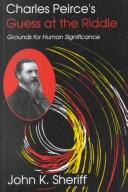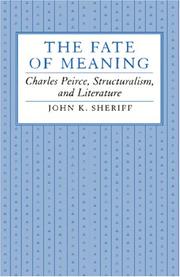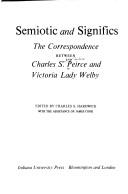| Listing 1 - 9 of 9 |
Sort by
|
Book
ISBN: 2707349054 9782707349057 Year: 2023 Publisher: Paris: Les éditions de minuit,
Abstract | Keywords | Export | Availability | Bookmark
 Loading...
Loading...Choose an application
- Reference Manager
- EndNote
- RefWorks (Direct export to RefWorks)
"Consacré à la pensée du philosophe, logicien et mathématicien Charles Sanders Peirce, ce numéro s'ouvre sur la traduction et la présentation, par Bruno Leclercq, du texte « Les mathématiques les plus simples » (1902). Comme Frege et contre Kant, Peirce affirme le caractère essentiellement déductif des mathématiques, qui ne sont pas la science de la quantité, mais des conclusions nécessaires. Comme Frege et l'école de Boole, il élabore des langages formels pour contrôler l'exactitude des déductions ; mais, voulant comme Kant rendre compte du caractère synthétique des inférences et de bien des énoncés mathématiques, il accorde son attention au rôle sémiotique qu'a le travail de construction et de transformation de diagrammes, entendant prolonger ainsi la théorie kantienne du schématisme.Si Peirce partage avec maints pragmatistes une méfiance à l'égard de la métaphysique, il en a pourtant revendiqué la possibilité et la nécessité. Dans « Peirce et la possibilité de la connaissance métaphysique », Claudine Tiercelin montre que ce projet métaphysique pragmaticiste qui, sur fond de réalisme, met l'accent sur la logique, la sémiotique, l'enquête et la science, est une source d'inspiration pour qui veut répondre au « défi de l'intégration » et penser les liens entre métaphysique et épistémologie - objectif auquel le métaphysicien doit s'atteler s'il veut poser les conditions de possibilité d'une authentique connaissance métaphysique.Lorsque, dans son enquête pragmaticiste sur la signification, il entend clarifier ce en quoi consiste la signification, Peirce recourt souvent à une phrase de Jean de Salisbury selon laquelle les noms « nomment des singuliers, mais signifient des universaux ». Quel est l'intérêt de cette référence ? Dans « Peirce et Jean de Salisbury sur le sens », Jean-Marie Chevalier montre que par un usage détourné de la citation, Peirce met en place quelques jalons de sa théorie sémiotique, pragmatiste et réaliste de la signification.Dans « Peirce face à Hegel : idéalisme, réalisme, nominalisme », Olivier Tinland s'attache à l'attitude de Peirce à l'égard de Hegel, qui semble ambivalente, voire peu cohérente. Si Peirce loue le souci qu'a Hegel de montrer l'importance des trois catégories universelles, en particulier celle de la Tiercéité, il lui reproche de réduire les deux premières catégories à la troisième et de céder à une forme insidieuse de nominalisme. L'auteur évalue la pertinence de ces critiques, notamment celles qui touchent au statut ontologique du possible et des catégories universelles.Enfin, dans « Lois et limites de l'institution symbolique : Husserl confronté à Peirce et Frege », D. Pradelle se focalise sur l'acte d'institution symbolique qui fixe l'alphabet des signes : ce dernier relève-t-il de la libre instauration d'un sens opératoire ou obéit-il à des lois ? En ce dernier cas, quelle en est la provenance ? L'auteur montre qu'elles proviennent des couches supérieures de la signification et des objets idéaux, ce qui a pour conséquence de soustraire le concept de constitution transcendantale au paradigme d'une libre production."
Metaphysics --- Logic --- Mathematics --- Peirce, Charles S. (Charles Sanders), 1839-1914

ISBN: 0585099715 9780253116536 0253116538 9780585099712 0253352045 9780253352040 0253208807 9780253208804 Year: 1994 Publisher: Bloomington Indiana University Press
Abstract | Keywords | Export | Availability | Bookmark
 Loading...
Loading...Choose an application
- Reference Manager
- EndNote
- RefWorks (Direct export to RefWorks)
Aims to expound Peirce's unified theory of the universe from cosmology to semiotic and to discuss its ramifications for how we should live. This book shows that Peirce's answer to the riddle of the Sphinx has the potential to be a powerful, positive force in contemporary culture. It concludes that Peirce has given us a theory we can live with.
Book
ISBN: 0197675824 9780197675823 9780197675830 Year: 2023 Publisher: New York, N.Y. Oxford University Press
Abstract | Keywords | Export | Availability | Bookmark
 Loading...
Loading...Choose an application
- Reference Manager
- EndNote
- RefWorks (Direct export to RefWorks)
"This book provides an action-theoretic view of political hope that draws on German idealism, critical theory, and American pragmatism. It offers an alternative to standard perspectives that reduce hope to either a subjective element of individual psychology or to the passive anticipation of the supposedly objective tendencies of the world itself. Featuring chapters on Immanuel Kant, Ernst Bloch, Charles Peirce, and William James, it presents hope instead as a practice of political action that both buttresses and promotes democratic experimentation. By reconstructing hope as a necessary condition for social and political engagement, it furthermore argues for the centrality of utopian thinking for practical action"--
Book
ISBN: 9783110695717 3110695715 3110695855 Year: 2022 Publisher: Berlin ; Boston : De Gruyter,
Abstract | Keywords | Export | Availability | Bookmark
 Loading...
Loading...Choose an application
- Reference Manager
- EndNote
- RefWorks (Direct export to RefWorks)
Our understanding of CS Peirce, and his semiotics, is largely influenced by a twentieth century perspective that prioritizes the sign as a cultural artifact, or as one that that 'distorts', in some way, our understanding of the empirical world. Such a perspective will always undermine appreciation of Peirce as a philosopher who viewed signs as the very mechanisms that enable us to understand reality through concept formation.The key to this repositioning of Peirce is to place his work in the broad frame of Hegelian philosophy. This book evaluates, in detail, the parallels that exist between Peircean and Hegelian thought, highlighting their convergences and also the points at which Peirce departs from Hegel's position. It also considers the work of Vygotsky on concept formation showing that both are, in fact, working within the same Hegelian template.This book, therefore, contributes to our broader understanding of Peircean semiotics. But by drawing in Vygotsky, under the same theoretical auspices, it demonstrates that Peirce has much to offer contemporary educational learning theory.
Book
ISBN: 3110123134 0899256414 3110849860 Year: 1990 Volume: vol 94 Publisher: Berlin New York Mouton de Gruyter
Abstract | Keywords | Export | Availability | Bookmark
 Loading...
Loading...Choose an application
- Reference Manager
- EndNote
- RefWorks (Direct export to RefWorks)
Logic --- Legal theory and methods. Philosophy of law --- Semiotics --- Peirce, Charles Sanders --- Langage juridique -- Sémantique --- Semantics (Law) --- Semantiek (Recht) --- Semeiotics --- Semiology (Linguistics) --- Semiotiek --- Sémantique (Droit) --- Sémantique juridique --- Sémiologie --- Sémiotique --- Séméiologie --- Séméiotique --- Law --- Semiotics (Law) --- Methodology. --- Peirce, Charles S. --- Semantics (Law). --- Semiotics (Law). --- Peirce, Charles S., --- Methodology --- Law - Methodology. --- Semiotics. --- Peirce, Charles S. (Charles Sanders), 1839-1914.
Book
ISBN: 9781847064660 1847064663 144114630X Year: 2009 Publisher: London Continuum
Abstract | Keywords | Export | Availability | Bookmark
 Loading...
Loading...Choose an application
- Reference Manager
- EndNote
- RefWorks (Direct export to RefWorks)
Charles S. Peirce, the founder of pragmatism, was also the architect of a remarkable theory of signs that continues to puzzle and inspire philosophers today. In this important new book, Mats Bergman articulates a bold new approach to Peirce's semeiotic through a reassessment of the role of rhetoric in his work. This systematic approach, which is offered as an alternative to formalistic accounts of Peirce's project, shows how general sign-theoretical conceptions can plausibly be interpreted as abstractions from everyday communicative experiences and practices. Building on this fallible ground o
Peirce, Charles Sanders --- Semiotics. --- Peirce, Charles Sanders, --- Peirce, Charles S. --- Communication. --- Peirce, Charles S. (Charles Sanders), 1839-1914. --- Semiotics --- Philosophy & Religion --- Philosophy --- Semeiotics --- Semiology (Linguistics) --- Semantics --- Signs and symbols --- Structuralism (Literary analysis) --- Peirce, C. S. --- Pirs, Charlz S., --- Peirce, Charles Santiago Sanders, --- Pʻo-erh-ssu, --- Pʻo-erh-ssu, Chʻa-li-ssu, --- Purs, Charls, --- Пърс, Чарлс, --- Chaersi Sangdesi Piersi, --- 查尔斯·桑德斯·皮尔斯, --- Peirce, Charles Sanders (1839-1914) --- Sémiotique --- Critique et interprétation --- Sémiotique --- Critique et interprétation

ISBN: 0253330475 Year: 1996 Publisher: Bloomington Indianapolis Indiana University Press
Abstract | Keywords | Export | Availability | Bookmark
 Loading...
Loading...Choose an application
- Reference Manager
- EndNote
- RefWorks (Direct export to RefWorks)
The nineteenth-century American philosopher and scientist Charles Sanders Peirce is considered to be one of the founders of semiotic, or the theory of signs. Although Peirce was a prolific writer, he never published his work on signs in an organized fashion, and as a result the scope of his thought is difficult to grasp. In this book, James Jakob Liszka presents a systematic and comprehensive account of Peirce's theory. Although there are excellent critical and expository studies of Peirce's semiotic, this book is the first to integrate all the various branches of semiotic into a coherent picture of what Peirce meant by the discipline. A general introduction for those unfamiliar with Peirce's theory, it is also an attempt to resolve some of the scholarly issues that surround the great American philosopher, and to help achieve some consensus on the more controversial matters of interpretation. Liszka begins with a general overview of the discipline of semeiotic (which is Peirce's preferred spelling). Semeiotic plays a critical role in the system of sciences as Peirce understood it. Since all investigation involves signs, semeiotic is pivotal since it not only provides a general understanding of signs, but also investigates their proper use in the process of inquiry, for both the natural sciences and cultural studies. The character of semeiotic in this regard turns out to be different from the semiology of Saussure, which was meant simply to be a branch of social psychology. Moreover, as a formal discipline, Peirce's semeiotic is broader than the contemporary sense of logic but incorporates most of its traditional concerns. Next, in a chapter on grammar, Liszka explores Peirce's notions of the essential characteristics of signs, their principal components, sign typology, and classification. This is followed by a discussion of critical logic, the proper use of signs in the investigation of the nature of things. Finally, Liszka explains universal rhetoric - the use of signs within discourse communities, the nature of communication, and the character of communities best suited to promote fruitful inquiry.
Semiotics --- Peirce, Charles Sanders --- Semiotics. --- Semeiotics --- Semiology (Linguistics) --- Semiotiek --- Sémiologie --- Sémiotique --- Séméiologie --- Séméiotique --- 82:003 --- 82:003 Semiotiek in de literatuur --- Semiotiek in de literatuur --- Semantics --- Signs and symbols --- Structuralism (Literary analysis) --- Peirce, Charles S. --- Peirce, Charles Sanders, --- Peirce, C. S. --- Pirs, Charlz S., --- Peirce, Charles Santiago Sanders, --- Pʻo-erh-ssu, --- Pʻo-erh-ssu, Chʻa-li-ssu, --- Purs, Charls, --- Пърс, Чарлс, --- Contributions in semiotics --- Congresses --- Peirce, Charles S. - (Charles Sanders), - 1839-1914 - Contributions in semiotics. --- Chaersi Sangdesi Piersi, --- 查尔斯·桑德斯·皮尔斯,

ISBN: 0691631034 1400859972 9781400859979 0691067627 0691014507 9780691067629 9780691014500 0691601291 9780691601298 Year: 1989 Publisher: Princeton, New Jersey
Abstract | Keywords | Export | Availability | Bookmark
 Loading...
Loading...Choose an application
- Reference Manager
- EndNote
- RefWorks (Direct export to RefWorks)
This succinct and lucid study examines the thought of the philosopher Charles Peirce as it applies to literary theory and shows that his concept of the sign can give us a fresh understanding of literary art and criticism. John Sheriff analyzes the treatment of determinate meaning and contends that as long as we cling to a notion of language that begins with Saussure's dyadic definition of signs, meaning cannot be treated as such any more than can essence or presence. Asserting that Peirce's less familiar position offers a way out of this difficulty, Sheriff first discusses the Saussurean-based theory of meaning and then argues for the advantages of the radically different triadic theory developed by Peirce.Part One of the work reviews and critiques the treatment of meaning in works by Jonathan Culler, Tzvetan Todorov, Stanley Fish, Roland Barthes, and Jacques Derrida, among others. The focus of this section is on the treatment of meaning in structural and post-structural theories and their common basis in Saussurean linguistics. Part Two provides a readable introduction to Peirce's general theory of signs and develops comprehensively the implications of his semiotic. The substitution of his theory for Saussure's opens our eyes to new and cogent answers to many questions relevant to the meaning of texts.Originally published in 1989.The Princeton Legacy Library uses the latest print-on-demand technology to again make available previously out-of-print books from the distinguished backlist of Princeton University Press. These editions preserve the original texts of these important books while presenting them in durable paperback and hardcover editions. The goal of the Princeton Legacy Library is to vastly increase access to the rich scholarly heritage found in the thousands of books published by Princeton University Press since its founding in 1905.
Hermeneutics. --- Literature -- Philosophy. --- Meaning (Psychology). --- Peirce, Charles S. -- (Charles Sanders), -- 1839-1914 -- Influence. --- Semiotics and literature. --- Literary semiotics --- Peirce, Charles Sanders --- Semiotics and literature --- Meaning (Psychology) --- Hermeneutics --- Literature - Philosophy --- Peirce, Charles Sanders, - 1839-1914 - Influence --- Peirce, Charles Sanders, - 1839-1914 --- Literature --- Literature and semiotics --- Psychology --- Literature and philosophy --- Philosophy and literature --- Interpretation, Methodology of --- Criticism --- Philosophy --- Theory --- Peirce, Charles S. --- Peirce, Charles Sanders, --- Peirce, C. S. --- Pirs, Charlz S., --- Peirce, Charles Santiago Sanders, --- Pʻo-erh-ssu, --- Pʻo-erh-ssu, Chʻa-li-ssu, --- Purs, Charls, --- Пърс, Чарлс, --- Chaersi Sangdesi Piersi, --- 查尔斯·桑德斯·皮尔斯, --- Influence. --- Philosophy.

ISBN: 0253351634 9780253351630 Year: 1977 Publisher: Bloomington, Ind. : Indiana University Press,
Abstract | Keywords | Export | Availability | Bookmark
 Loading...
Loading...Choose an application
- Reference Manager
- EndNote
- RefWorks (Direct export to RefWorks)
The original edition of Peirce's letters to Lady Welby, edited and published by Irwin Lieb in 1953, has been out of print for some years, and the present edition makes a much needed contribution to the now rapidly expanding collection of Peirce materials that is becoming readily accessible to the interested scholar. Whereas the original collection included only Peirce's letters to Lady Welby, the current edition has been expanded to include the complete correspondence of 1903-11 between Peirce and Lady Welby. The editor's justification for this expansion is well taken, for it enhances the value of the book, not just by providing an insight into Lady Welby's views on significs, or the science of meaning, but even more so by placing Peirce's letters in their proper context, thereby adding to the reader's understanding of the content of Peirce's letters.
Lexicology. Semantics --- Semiotics --- Welby, Victoria --- Peirce, Charles Sanders --- 003 --- Semeiotics --- Semiology (Linguistics) --- Semantics --- Signs and symbols --- Structuralism (Literary analysis) --- Semiotiek. Schriften. Tekens en symbolen. Codes. Grafische voorstellingen --- Peirce, Charles S. --- -Welby, Victoria Lady --- -Correspondence --- Correspondence --- 003 Semiotiek. Schriften. Tekens en symbolen. Codes. Grafische voorstellingen --- Welby, Victoria, --- Peirce, Charles Sanders, --- Peirce, C. S. --- Pirs, Charlz S., --- Peirce, Charles Santiago Sanders, --- Pʻo-erh-ssu, --- Pʻo-erh-ssu, Chʻa-li-ssu, --- Purs, Charls, --- Пърс, Чарлс, --- Gregory, Welby-, --- Stuart-Wortley, Victoria Alexandrina Maria Louisa, --- Welby-Gregory, --- Welby-Gregory, Victoria Alexandrina Maria Louisa Stuart Wortley, --- Welby, V. --- Correspondence. --- Semiotics. --- Welby-Gregory, Victoria, --- Chaersi Sangdesi Piersi, --- 查尔斯·桑德斯·皮尔斯, --- Lexicologie Semantiek. --- Semiotiek. --- Peirce, Charles S., --- Peirce, Charles S. - (Charles Sanders), - 1839-1914 --- Welby, Victoria, - Lady, - 1837-1912 --- Semantics (Philosophy)
| Listing 1 - 9 of 9 |
Sort by
|

 Search
Search Feedback
Feedback About UniCat
About UniCat  Help
Help News
News